There’s something special about hunting for amethyst in Arkansas that draws rockhounds from all over the country.
The crystals can be small and delicate or surprisingly substantial. Part of the appeal is never quite knowing what you’ll uncover when you split open a promising piece of matrix or dig into a fresh pocket.
It’s hands-on work. Expect to do some digging, breaking rock, and getting your hands dirty. But that’s half the fun!
Of course, knowing where to look makes all the difference between a frustrating day and coming home with specimens worth adding to your collection. You’ll need to know the best spots in the state where amethyst can actually be found.
What is Arkansas Amethyst?
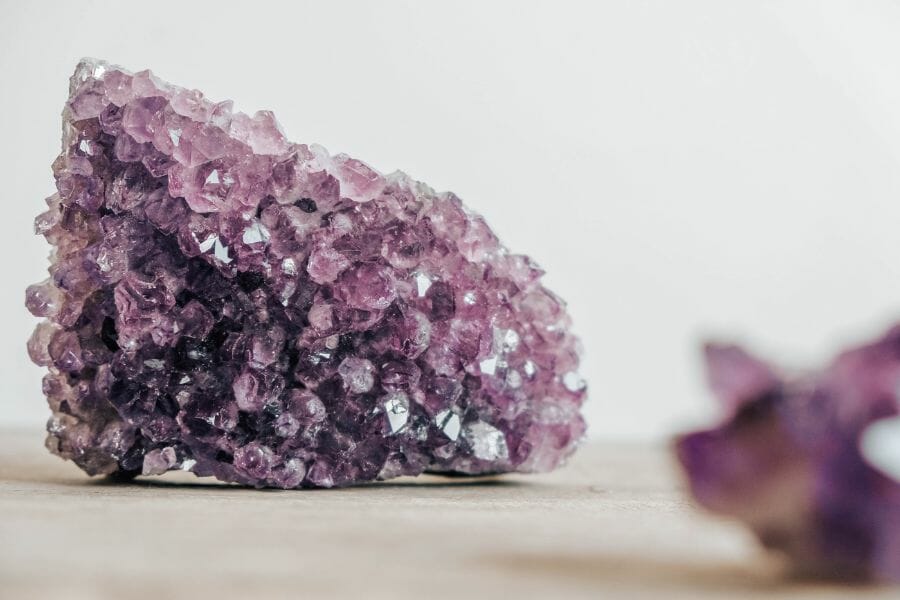
If you’re looking for a beautiful and mystical gemstone, look no further than amethyst! It’s a variety of quartz known for its stunning purple color, ranging from light lavender to deep violet. And it’s not just its appearance that makes amethyst unique – it’s also believed to have some powerful spiritual properties.
So where can you find amethyst? Well, it’s pretty abundant and can be found worldwide! If you’re feeling adventurous and want to hunt for your amethyst, research and find a location that allows for public mining. And who knows, you might strike it lucky and find your piece of amethyst treasure!
The Different Types Of Amethyst And What They Look Like
Different environments contribute to the diverse appearances and types of this beautiful mineral.
The variety seen in amethyst is due to trace elements and impurities within the crystal structure. Elements like iron and manganese can alter the hue, leading to the beautiful spectrum of purples and other colors found in these crystals.
Brandberg Amethyst
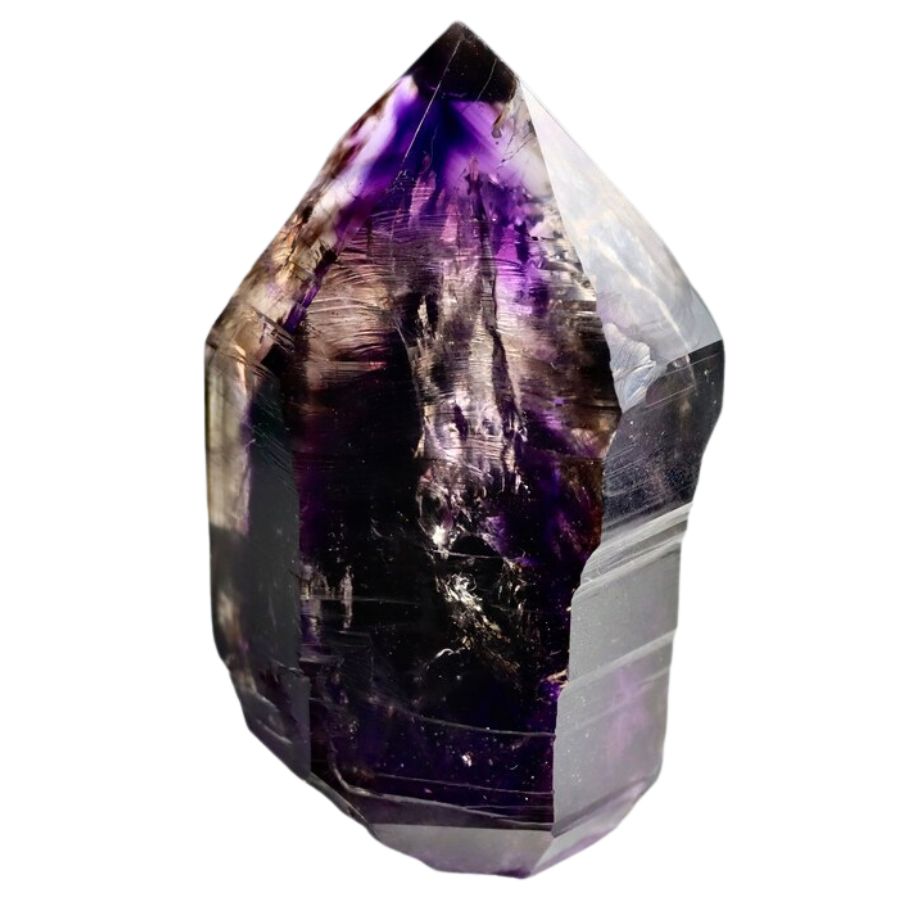
Brandberg amethyst is a captivating variety of quartz, renowned for its unique blend of elements like silicon dioxide, iron, and trace amounts of other minerals.
These components come together to form a crystal that not only holds geological significance but also showcases a striking array of hues and features.
The appearance of Brandberg amethyst is truly remarkable, characterized by its color range from deep purples to vibrant lilacs.
The varying shades are a result of the iron content within the crystal structure, which can fluctuate, leading to diverse color intensities and patterns in each specimen.
Brandberg amethyst stands out for its inclusion patterns and the presence of phantom crystals within its structure.
These internal “ghosts” are formed by layers of other minerals, offering a glimpse into the crystal’s growth history and adding to its allure for those fascinated by the wonders of the natural world.
Ametrine
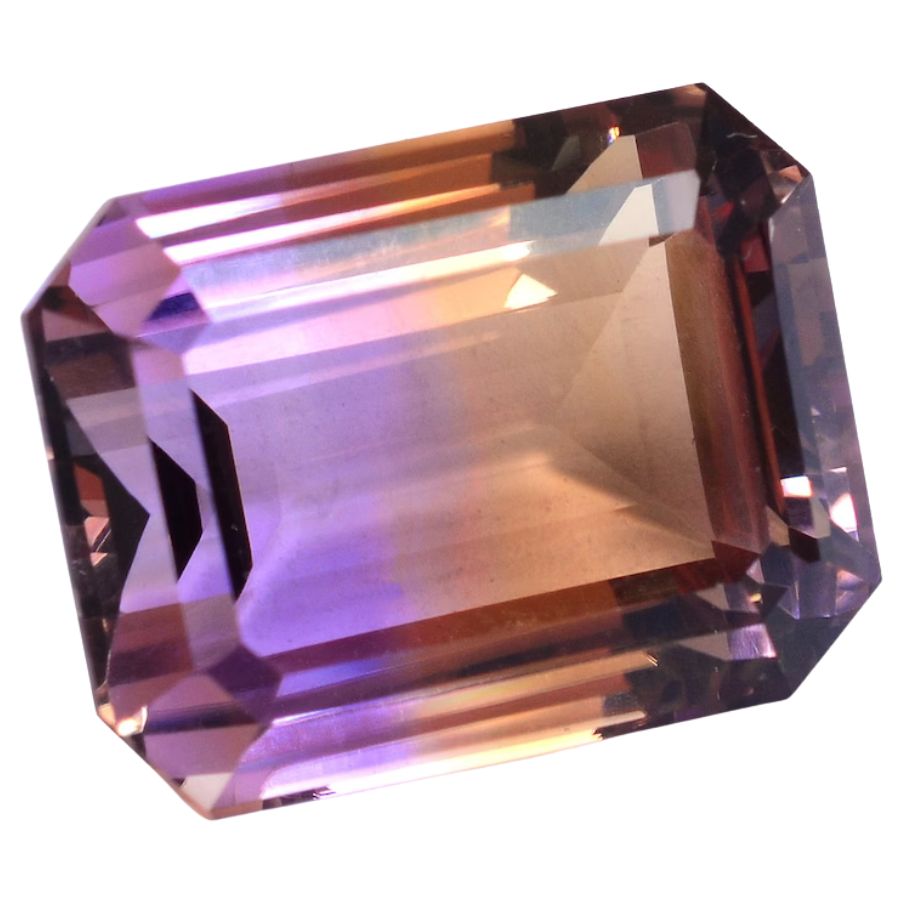
Ametrine is an intriguing mineral that captures the imagination of those interested in rocks and minerals. This unique gem is a combination of two quartz varieties: amethyst and citrine.
The beauty of ametrine lies in its striking coloration, which ranges from a blend of vibrant purple and golden yellow.
This color variation is a result of differing oxidation states of iron within the crystal, influenced by temperature and radiation exposure during formation.
Ametrine is notable for its distinct zoning of colors, where purple and yellow hues can be clearly seen in the same crystal. This feature, combined with its unique composition, sets ametrine apart from different kinds of amethyst.
Chevron Amethyst
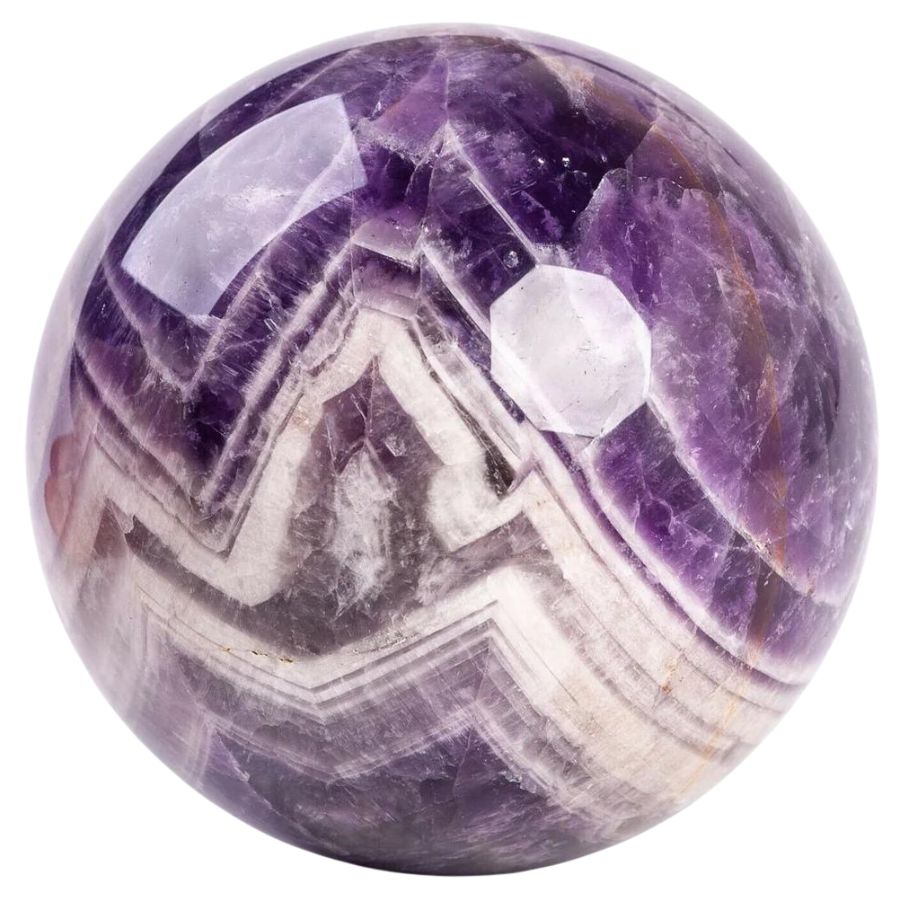
Chevron amethyst is a captivating type of amethyst known for its distinctive pattern. It’s easily recognized by its unique V-shaped or chevron patterns, which are a combination of deep purple and white or clear quartz layers.
These patterns and color variations are due to differences in iron content and other impurities in the layers, resulting in the striking contrast seen in chevron amethyst.
Chevron amethyst is not only beautiful but also a subject of interest for its formation process. The alternating layers of colors provide a visual record of the crystal’s growth history, making it a fascinating example for geological study.
Auralite
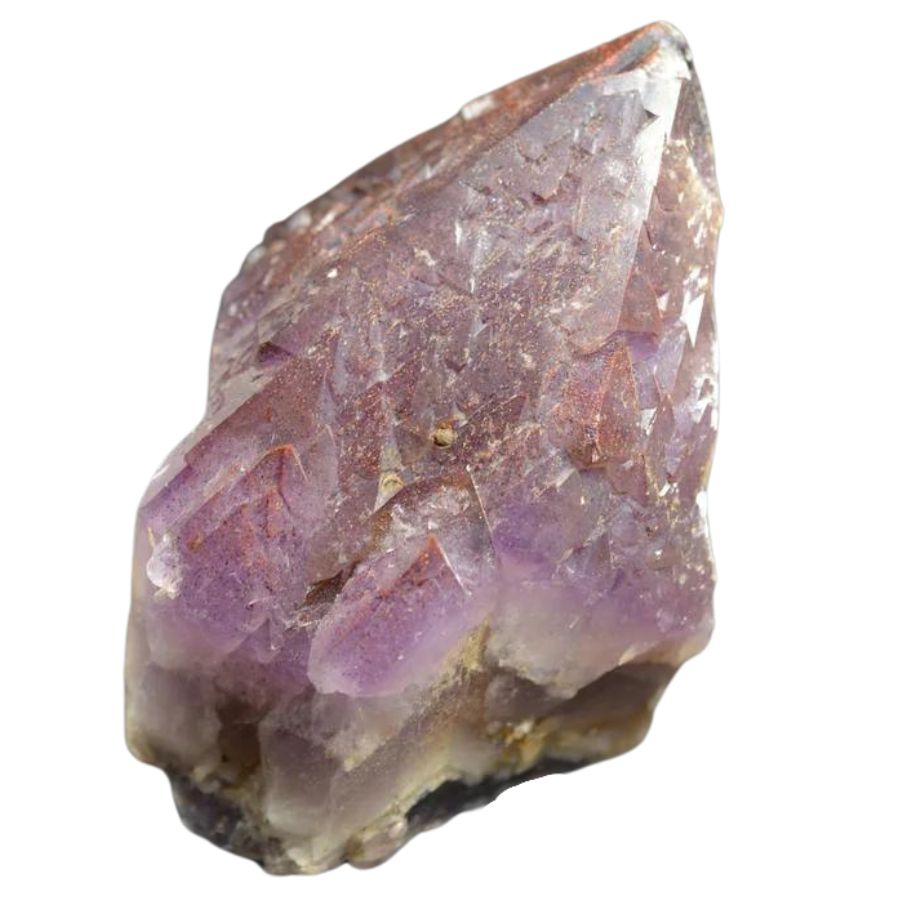
Auralite is an intriguing type of mineral that’s a combination of amethyst and several other trace minerals. Its composition includes silicon dioxide from amethyst, along with a mixture of elements like iron, copper, and titanium.
This mineral’s appearance is quite distinct, often showing a deep purple hue similar to what amethyst looks like, but with additional layers or inclusions of other colors.
These variations in color are due to the various trace minerals present in auralite, each contributing to its unique and colorful display.
A standout feature of auralite is the presence of multiple minerals within a single specimen, sometimes including up to 23 different types.
This mix not only gives auralite its diverse color range but also makes it a fascinating subject for those studying minerals and their properties.
Prasiolite
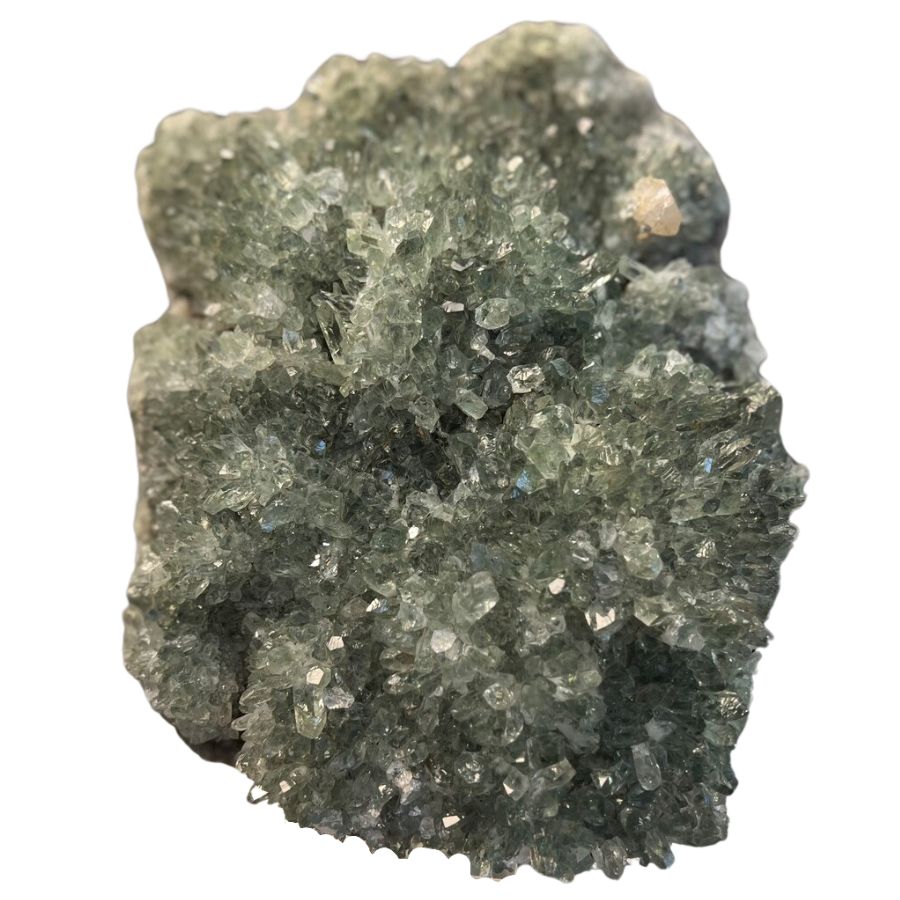
Prasiolite is an interesting variety of quartz. It often contains traces of iron, which play a key role in giving prasiolite its unique color.
This mineral is known for its beautiful green color, which can range from a light, almost transparent green to a deeper, more olive shade.
The green color of prasiolite is usually the result of heat treatment, either occurring naturally in the earth or artificially, transforming certain types of amethyst or yellowish quartz into prasiolite.
Naturally-occurring prasiolite is rare, as most available prasiolite is created through artificial means.
Cacoxenite amethyst

Cacoxenite is an intriguing mineral primarily composed of iron, aluminum, and phosphate, along with other elements like oxygen and hydrogen. This combination of elements gives cacoxenite its unique chemical makeup and properties.
Cacoxenite typically exhibits a striking golden-yellow to brownish-yellow color. This coloration is mainly due to the presence of iron in its structure, which imparts the rich hues that characterize this mineral.
A notable feature of cacoxenite is that it often forms as an inclusion within other minerals, such as amethyst, creating a beautiful contrast.
These inclusions of cacoxenite can appear as radiating or feathery formations, adding an intricate and fascinating aspect to the host mineral.
Phantom Amethyst
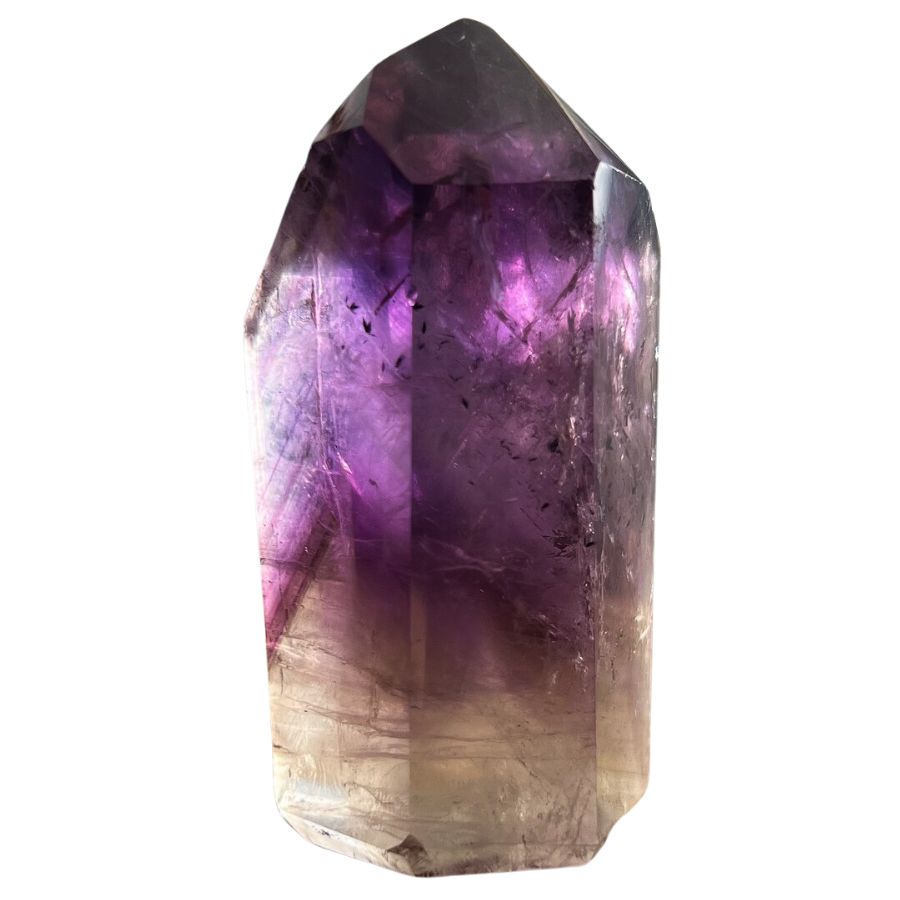
Phantom amethyst is a fascinating variety of amethyst. It stands out due to the presence of “phantoms” – ghost-like inclusions within its structure, which give it a distinct and layered look.
In phantom amethyst, one can observe a range of colors from deep purples to lighter hues, often appearing in layers or as phantom shapes within the crystal.
These color variations are typically due to trace amounts of iron and other minerals that get trapped during the crystal’s growth, influencing its final color.
Phantom amethyst provides a visual record of the crystal’s growth history. The crystal outlines and layers within the stone are formed by pauses in the crystal’s growth, offering a glimpse into geological processes over time.
Pink Amethyst
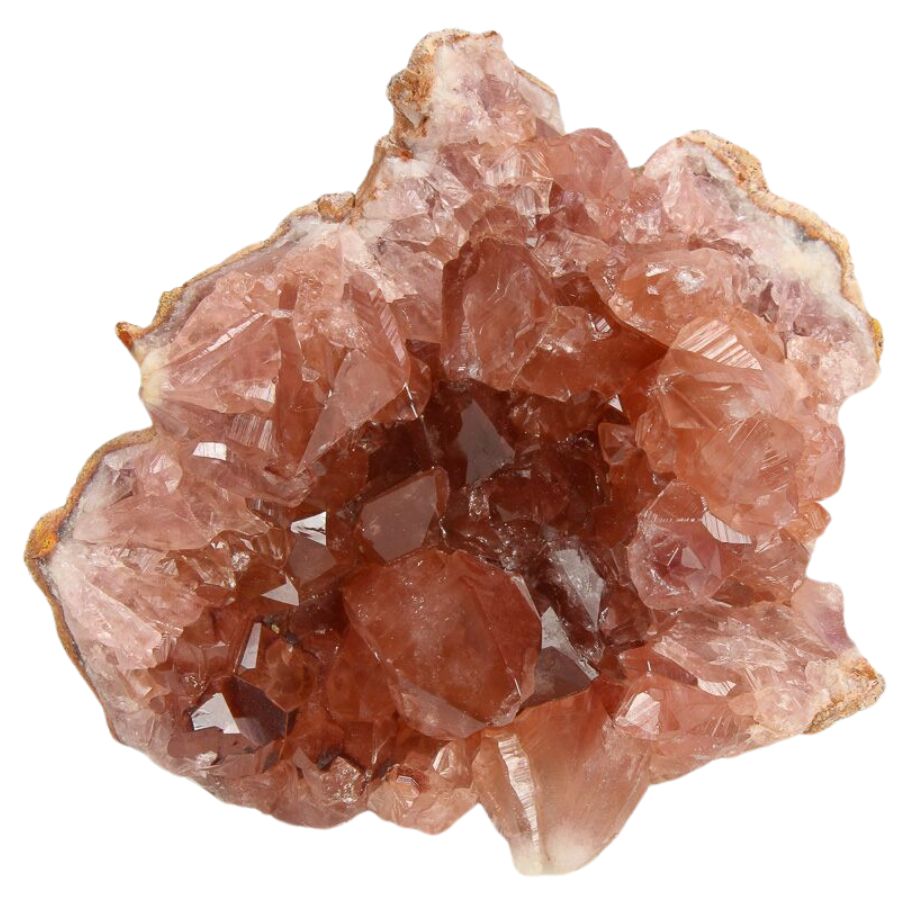
Pink amethyst is a unique and relatively rare variety of the common mineral amethyst. The presence of trace elements, particularly iron, contributes to its distinct pink hue.
The appearance of pink amethyst ranges from a delicate, light pink to a deeper, more vivid pink.
This variation in color is largely due to the concentration and distribution of iron within the crystal, which affects how light interacts with the mineral.
Pink amethyst is its often found in geodes or clusters, where multiple crystals grow together in a captivating display.
Amethyst Geodes
Amethyst geodes are fascinating natural formations, with traces of iron giving them their famous purple color. These geodes form in volcanic rocks and are essentially hollow, lined with amethyst crystals.
A key feature of amethyst geodes is their crystal-lined cavity, which creates a stunning natural display. When you look inside an amethyst geode, you’ll see a range of purple hues, from light lavender to deep violet.
The color variation is due to the amount of iron and the specific conditions under which the crystals formed, such as temperature and the presence of other trace elements.
Geodes can vary greatly in size, from small enough to fit in your hand to large enough to stand in, and each one is unique in its crystal formation and color pattern.
Cactus Amethyst
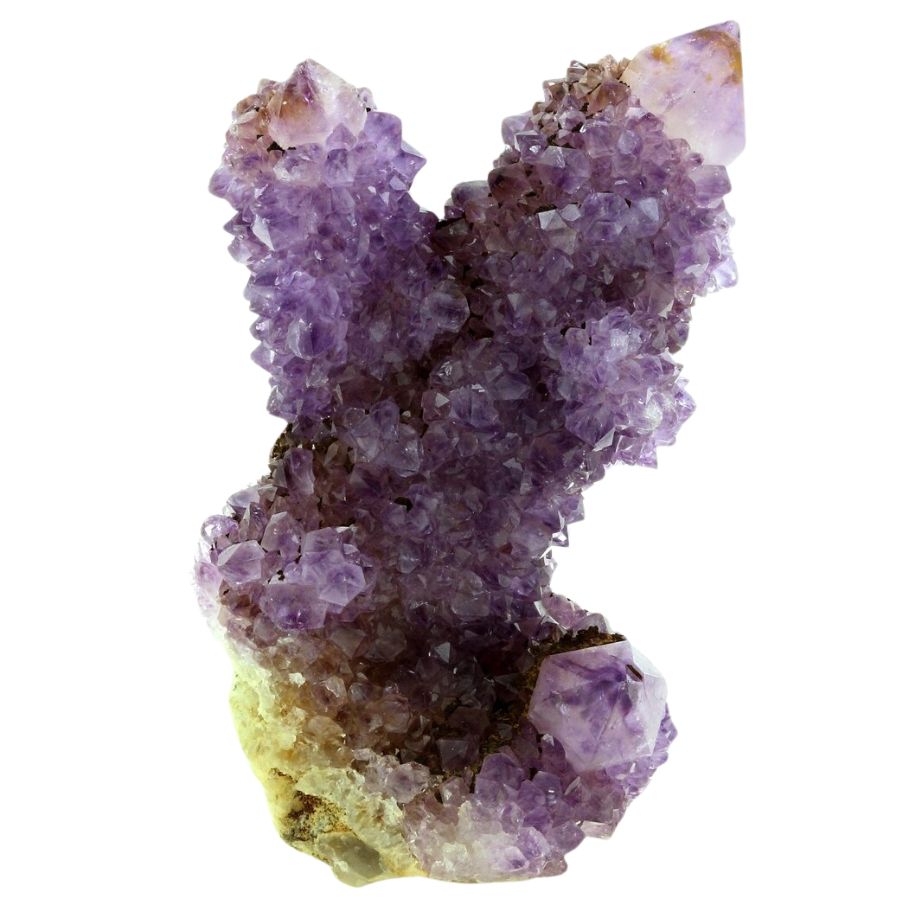
Cactus amethyst is also known as spirit quartz. Its unique structure is enriched with additional minerals, which contribute to its distinctive appearance.
This type of amethyst is characterized by a central quartz crystal covered in smaller crystal growths, giving it a spiky, cactus-like appearance.
The color ranges from pale lilac to deep purple, with the variations largely influenced by the amount of iron and other trace elements within the crystals.
A notable feature of cactus amethyst is the way the smaller crystals radiate outward from the central crystal.
This formation not only creates a stunning visual effect but also makes each piece of cactus amethyst a unique and fascinating specimen.
Regarding the price of amethyst, it can vary significantly based on the size, quality, and depth of color. While smaller, less vibrant pieces are relatively affordable, larger specimens with deep, rich colors can be quite valuable.
Scepter Amethyst
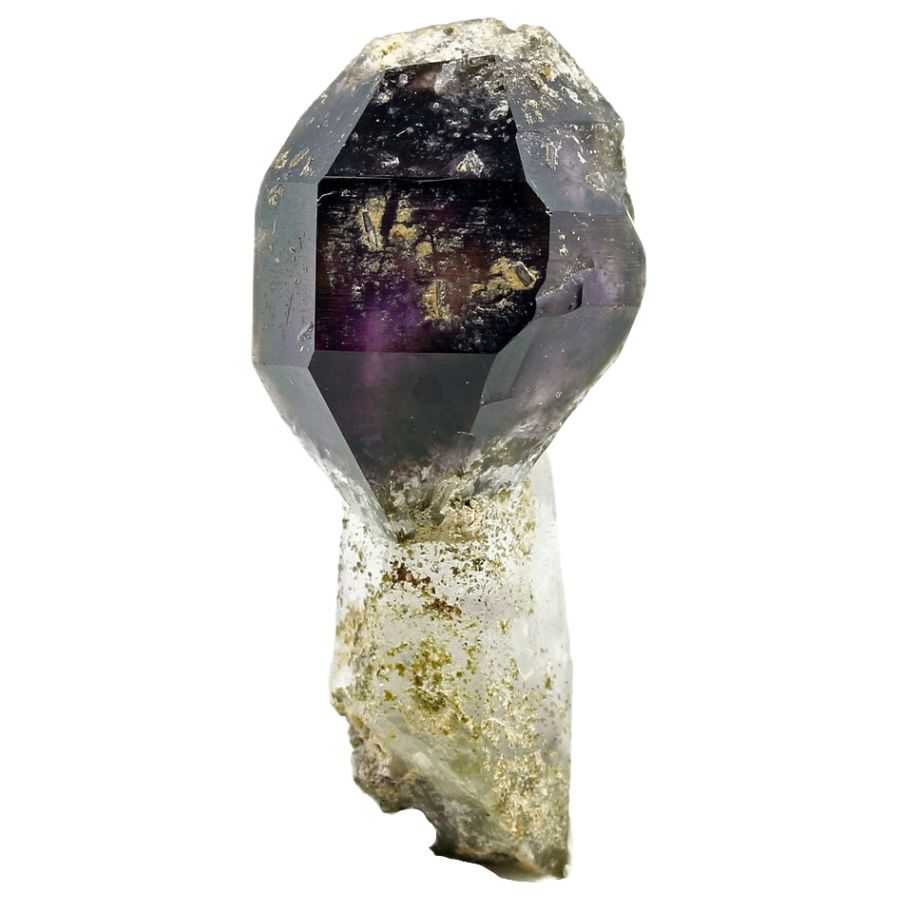
Scepter amethyst gets its name from its distinctive scepter-like formation, where a larger crystal cap sits atop a smaller crystal stem.
The color variations in scepter amethyst are influenced by the amount of iron and other trace elements within the crystal, coupled with the specific conditions under which it formed.
A key feature of scepter amethyst is its symbolic scepter shape, representing a crystal formation process where a second phase of growth occurs on an already-formed crystal base. This creates a striking and regal scepter-like appearance.
Smoky Amethyst
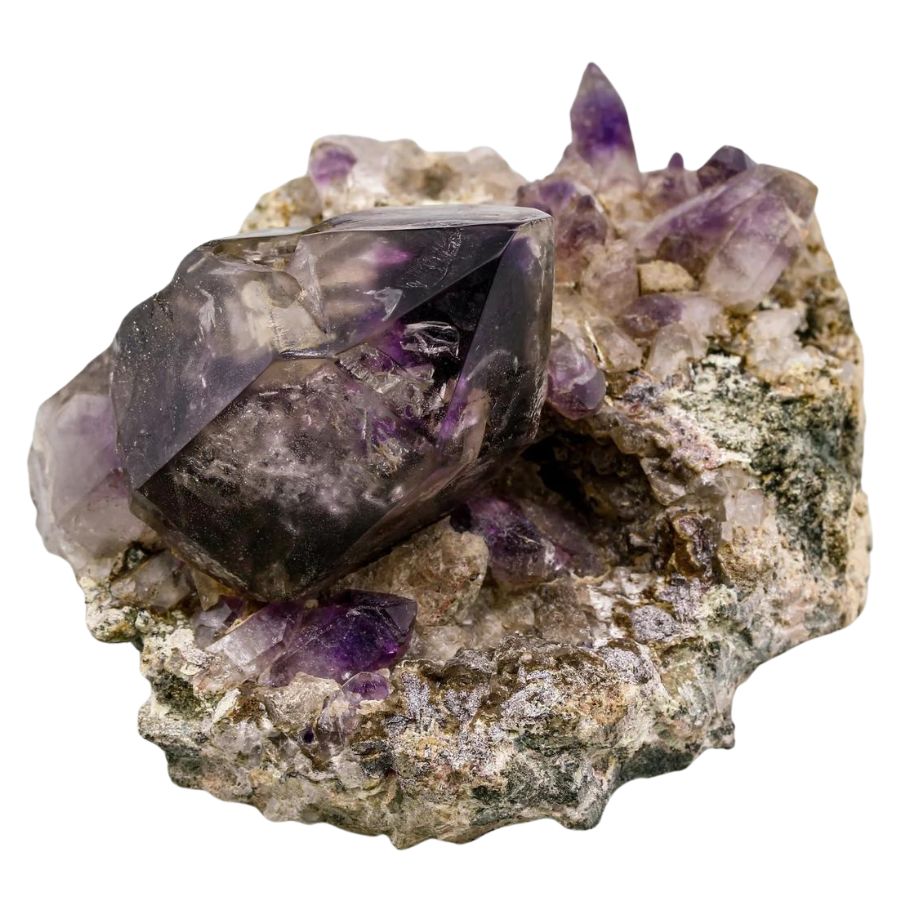
Smoky amethyst is a unique variation among amethyst types that combines features of both smoky quartz and amethyst. The presence of trace elements like iron and aluminum gives it its unique coloration.
This mineral exhibits a blend of smoky brown and purple hues, creating a captivating visual effect. This is due to natural irradiation and the varying amounts of impurities, which influence the depth and intensity of both the smoky and purple colors.
A notable feature of smoky amethyst is its dual-tone appearance, which is not commonly found in other quartz varieties.
- The deep experience and understanding of our team about the area
- Recommendations from local groups and clubs
- How easy it is to get the a particular location
- Safety and potential hazards when collecting
- Weighing private and public locations
- The ability for both experienced and novice amethyst enthusiasts to find great samples
With these factors in mind we’ve been able to put together a fantastic list that just about anyone can use!
The Best Spots To Find Amethyst in Arkansas
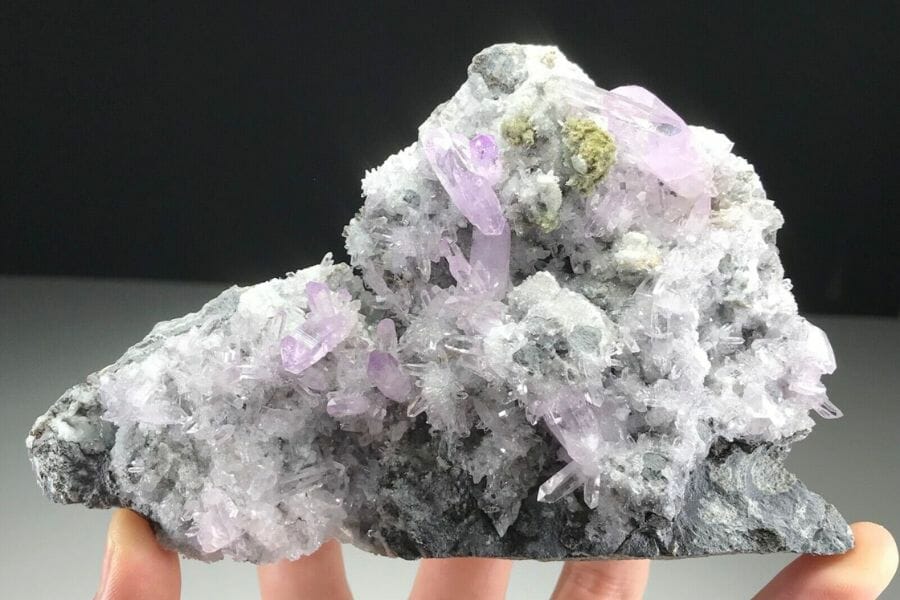
Here are our best recommendations for finding amethysts in the state. We have a lot of unique places where you can find gems in Arkansas, but only a few are particularly good for discovering amethysts. Even if some of these locations weren’t popular, we looked there and discovered intriguing options.
Crater of Diamonds State Park

If you’re looking for a unique and exciting adventure, Crater of Diamonds State Park in Arkansas is worth checking out! This park is home to a 37.5-acre plowed field where you can search for diamonds and other gemstones, including amethysts. Amethysts are one of the many types of gemstones that have been found at the park over the years.
What makes Crater of Diamonds State Park such a great location for amethyst hunting is that it’s one of the few places in the world where the public can search for diamonds and other gemstones in their natural state. The park is located on an ancient volcanic crater, which means that the soil is rich in minerals and has the potential to yield some incredible finds.
Before bringing anything home, familiarize yourself with the most recent Arkansas collecting regulations.
Where we found amethyst in Crater of Diamonds State Park
Amethysts are typically found in the same geological formations as diamonds, so it’s not uncommon to find them in the same areas within the park’s 37.5-acre search area.
If you want REAL results finding incredible rocks and minerals you need one of these 👇👇👇
Finding the coolest rocks in isn’t luck, it's knowing what to look for. Thousands of your fellow rock hunters are already carrying Rock Chasing field guides. Maybe it's time you joined the community.
Lightweight, mud-proof, and packed with clear photos, it’s become the go-to tool for anyone interested discovering what’s hidden under our red dirt and what they've already found.
Join them, and make your next rockhounding trip actually pay off.
What makes it different:
- 📍 Find and identify 140 incredible crystals, rocks, gemstones, minerals, and geodes across the USA
- 🚙 Field-tested across America's rivers, ranchlands, mountains, and roadcuts
- 📘 Heavy duty laminated pages resist dust, sweat, and water
- 🧠 Zero fluff — just clear visuals and straight-to-the-point info
- ⭐ Rated 4.8★ by real collectors who actually use it in the field
Arkansas Talc Co. Mine
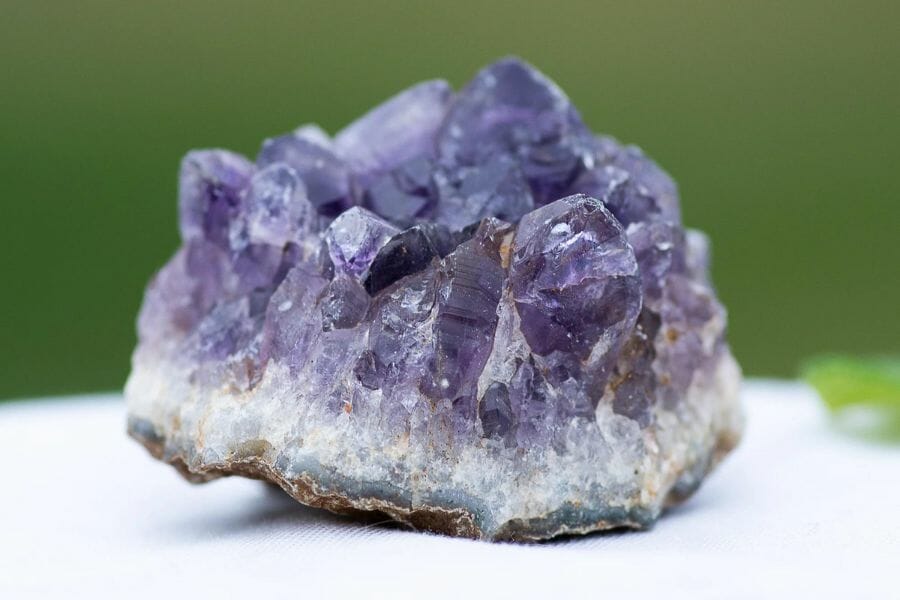
If you’re on the hunt for amethysts in Arkansas, you might want to consider visiting the Arkansas Talc Co Mine in Saline County. This mine is one of the best ways to find amethyst we know of and is located just outside of Little Rock and has been a popular spot for rockhounds and mineral enthusiasts for many years. While the mine is primarily known for its talc deposits, it has also been known to contain some beautiful amethysts and other minerals in the area.
To increase your chances of finding amethysts at the Arkansas Talc Co Mine, it’s important to do your research and understand the mining regulations in the area. The mine is privately owned, so you’ll need to obtain permission before entering the property.
Where we found amethyst at the Arkansas Talc Co Mine
At the Arkansas Talc Co Mine in Arkansas, you can find amethysts in the same geological formations as quartz and other minerals. The mine is located in the Ouachita Mountains, which are known for their rich quartz veins and pockets. Here are the current amethyst crystal prices in the market for your knowledge.
East Wilson Pit
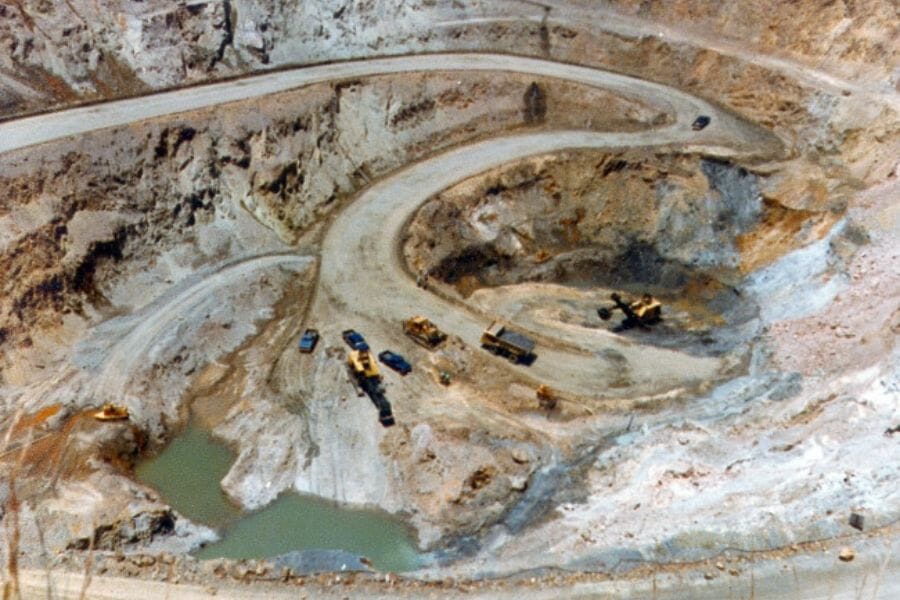
If you’re looking for a unique and promising location to hunt for amethysts in Arkansas, East Wilson Pit is definitely worth checking out. This abandoned mine has become a popular spot for rockhounds and mineral collectors due to its rich deposits of quartz and other minerals, including amethysts.
One of the reasons why East Wilson Pit is such a great location for amethyst hunting is because of its unique geological formations. The mine is situated in an area with a high concentration of quartz veins and pockets, where amethysts are often found. Additionally, the pit’s abandoned status means fewer restrictions on exploration and collecting.
Where we found amethyst at the East Wilson Pit
Amethysts at East Wilson Pit can be found as individual crystals or in small clusters. Amethysts can be found throughout the pit, but it’s important to be careful when exploring and to follow all safety regulations.
Little Missouri River

The Little Missouri River is a great option if you’re looking for amethyst crystals in the state. This scenic river is known for its crystal clear waters and rich deposits of minerals, including amethysts.
One of the reasons the Little Missouri River is a great location for amethyst hunting is its unique geological formations. The river flows through an area with a high concentration of quartz veins and pockets, where amethysts are often found.
Additionally, the river’s natural erosion process means that gemstones are often washed downstream and deposited in gravel bars and other locations along the riverbanks.
Where we found amethyst at the Little Missouri River
Amethysts can be found in various locations along the riverbanks of the Little Missouri River.
Prairie Creek

Prairie Creek is a picturesque and serene location that is known for its natural beauty and rich deposits of minerals, including amethysts. This creek flows through an area of the Ouachita Mountains that is rich in quartz veins and pockets, making it a promising location for rockhounds and mineral enthusiasts.
Prairie Creek is such a great location for amethyst hunting because of its accessibility. Unlike some other locations in Arkansas, Prairie Creek is located on public land and does not require permission to access. This makes it an ideal spot for amateur rockhounds and families who want to enjoy a fun and educational day out.
Where we found amethyst at Prairie Creek
You can find amethyst crystals in all the regional silver mines around Willow Creek, where they produce both amethyst crystals and clusters in their dumps.
Other Great Places To Mine For Amethyst in Arizona
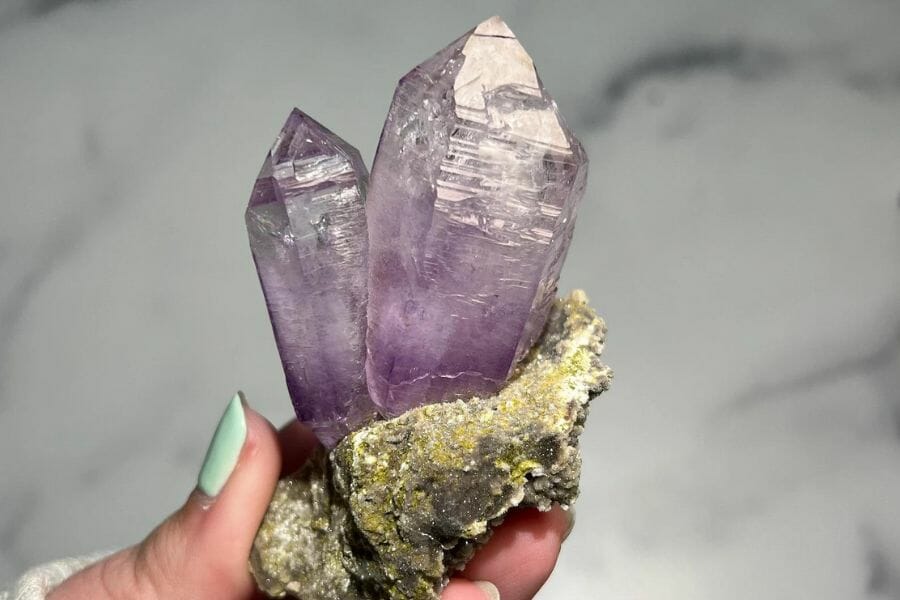
Additional areas you can find amethyst
Given that Arkansas is such a big state, we want to assist you in your adventure. The essential and targeted locations where amethysts are typically found should be searched.
Mines and mine dumps
Mines and mine dumps can be great locations for amethyst collectors to find their next stunning piece. Mines and mine dumps often contain minerals, including amethysts, that have naturally occurred in the area for millions of years. Over time, these minerals have accumulated and formed beautiful crystals just waiting to be discovered.
Mines and mine dumps provide a unique opportunity for collectors to search for amethysts in their natural state. Unlike purchasing stones from a dealer or retailer, finding an amethyst from a mine or mine dump allows collectors to experience the excitement and thrill of finding a gemstone firsthand.
Rivers and riverbanks
Rivers and riverbanks are natural and beautiful locations that offer great opportunities for amethyst collectors to find their next gemstones. These locations are excellent for amethyst hunting because the flow of water naturally sorts rocks and minerals, including amethysts, along the banks and riverbeds. The rushing water can also wear down rocks and gravel, revealing beautiful crystals hidden for millions of years.
Rivers and riverbanks are often easily accessible and located in picturesque settings. This makes them a great location for nature enthusiasts and rockhounds alike to enjoy a day out while searching for beautiful gemstones
Streams and creeks
Streams and creeks are other natural location that offers excellent opportunities for amethyst collectors to find beautiful gemstones. The same forces that make rivers and riverbanks ideal for amethyst hunting, such as water flow and natural sorting of rocks and minerals, also make streams and creeks prime locations for finding amethysts.
One advantage of searching for amethysts in streams and creeks is that they are often less crowded than other locations, making it easier to focus on finding gemstones. Another advantage is that they are typically located in remote and natural settings, providing a peaceful and enjoyable environment for collectors to explore.
Common Amethyst-Hunting Questions
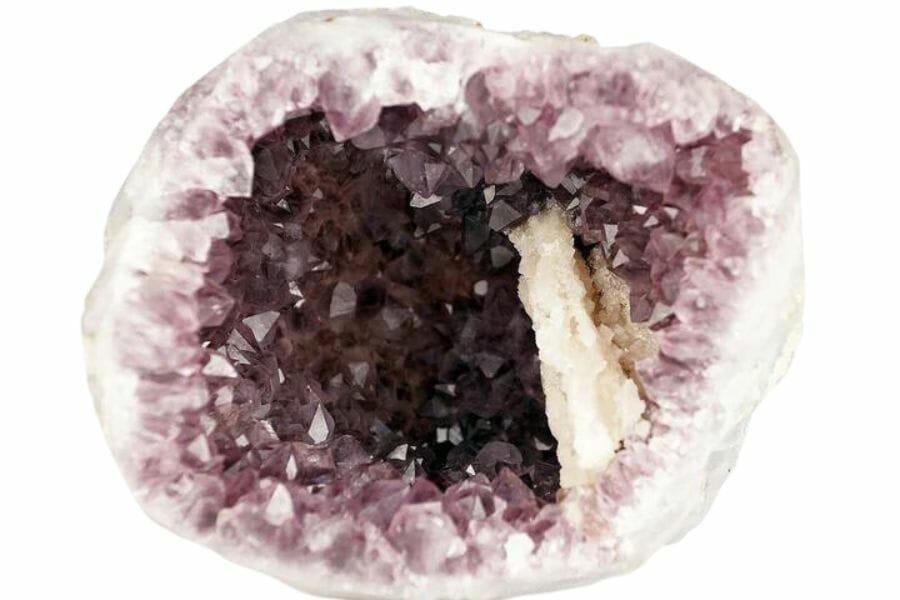
Addressing the following frequently asked questions concerning amethysts in Arkansas is critical.
Where can you find amethyst geodes in Arkansas?
Although amethyst geodes are not normally found in Arkansas, you can find other specimens at a few rock shops.
Is it illegal to collect amethyst in Arkansas?
Arkansas allows amethyst collection as long as you adhere to local laws. If you’re in public spaces, abide by any applicable laws. If you’re on private land, make sure you have permission.
The Best Places To Buy Amethyst In Arkansas
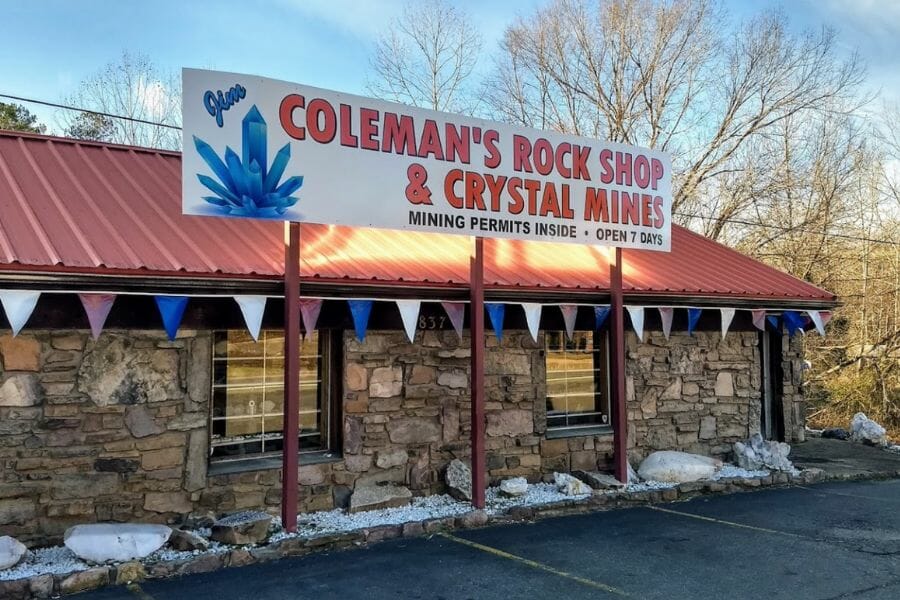
Not everyone finds it pleasurable to spend hours in the woods searching for amethysts. Sometimes all you require is a superb and distinctive presentation or something to bolster your collection. The following is a list of rock stores where you can buy amethyst crystals.
- Amethyst Sky – 1533 E Harding St, Morrilton, AR 72110
- Avant Mining Fisher Mountain Rock Shop and Public Dig – 11 Logan Gap Rd, Mt Ida, AR 71957
- Coleman Rock Shop and Crystal Mines – 5837 AR-7, Jessieville, AR 71949
- Twin Creek Crystal Mine – Collier Springs Rd #177, Mt Ida, AR 71957
- Wegner Quartz Crystal Mines – 82 Wegner Crystal Ranch Rd, Mt Ida, AR 71957
Additional Places To Find Amethyst In Nearby States
If you’ve already tried all of our recommendations above or are planning a trip out of the state you should check out our guides for neighboring states:
If you have any recommendations for our list, please leave a comment below!



